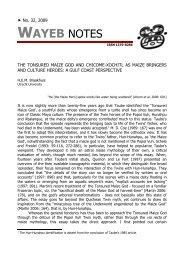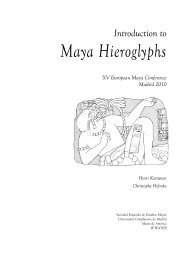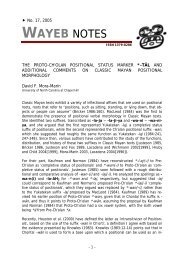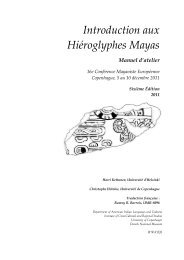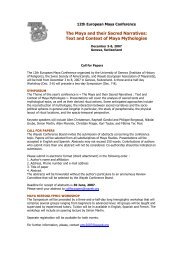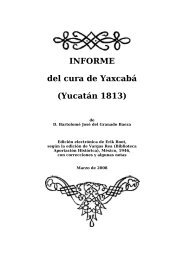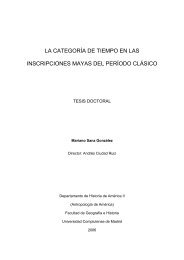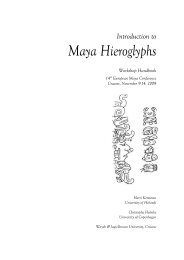Introduction to Maya Hieroglyphs - Wayeb
Introduction to Maya Hieroglyphs - Wayeb
Introduction to Maya Hieroglyphs - Wayeb
Create successful ePaper yourself
Turn your PDF publications into a flip-book with our unique Google optimized e-Paper software.
Kettunen & Helmke 2011<br />
Glossary of Linguistic Terminology<br />
glide<br />
A sound produced more or less like a VOWEL but with the distributional properties of a CONSONANT. Glides are<br />
more commonly referred <strong>to</strong> as “semi-vowels” and classified also as approximants. In Classic <strong>Maya</strong> there are two<br />
glides (or semi-vowels): [j] and [w] (written GRAPHEMICALLY as and , respectively, and pronounced very<br />
much like the English phonemes /y/ and /w/ in words like “year” and “wine”).<br />
gloss<br />
A short general translation of a WORD or MORPHEME which does not take in<strong>to</strong> account the context in which it<br />
occurs.<br />
glottal<br />
A sound produced by a constriction in the GLOTTIS (the air passage through the larynx or voicebox between the<br />
vocal folds). The two most common glottal sounds are the GLOTTAL s<strong>to</strong>p (or glottal plosive) [’] 86 and the glottal<br />
FRICATIVE [h]. A glottal s<strong>to</strong>p involves closure, followed by release, of the vocal cords, whereas a glottal fricative<br />
involves close approximation between the vocal cords. In a few English accents, the glottal s<strong>to</strong>p can be heard in<br />
words like “bottle” [bo’l], and they often replace syllable final plosives, as in “Scotland” [sko’lnd], but more<br />
commonly in any initial word in a sentence starting with a vowel, and in expressions such as “uh-uh” (colloquial<br />
phrase indicating a negative opinion or a refusal) and “oh-oh” (“oops”; colloquial expression referring <strong>to</strong> an<br />
element of surprise).<br />
glottis<br />
The aperture between the vocal folds.<br />
grammar<br />
The habitual method in which the basic elements of a language are interconnected <strong>to</strong> create more complex<br />
structures, thus enabling thoughts <strong>to</strong> be communicated according <strong>to</strong> clear, habitual and systematic configuration.<br />
grapheme<br />
A “default” letter in the alphabet or a symbol representing a syllable in a syllabary. For example, in the <strong>Maya</strong><br />
script the symbol for the syllable ba is a single grapheme regardless of the different forms in which it may be<br />
written. In Latin alphabet a grapheme is any given letter (or letters) with no direct correspondence <strong>to</strong><br />
pronunciation. See also DIGRAPH.<br />
homograph<br />
A word written exactly the same way as another word with different meaning, and potentially different<br />
pronunciation, e.g. minute [‘minit] (a unit of time and angular measurement) and minute [mī:nyüt] (of very small<br />
size or importance).<br />
homophone<br />
A group of letters or (in a broad sense of the definition) a word written differently from another word with same<br />
pronunciation, e.g. right, rite, wright, and write. Homophones can also be distinguished from homonyms in a sense<br />
that homophones represent a group of letters representing the same speech sound, whereas homonyms are words<br />
that have the same pronunciation as another, (usually) differently written, word.<br />
86<br />
The more appropriate symbol for the glottal s<strong>to</strong>p is a character resembling a question mark but for typographical reasons the symbol < ’ > is<br />
used here instead. This practice is also in keeping with the standards employed by <strong>Maya</strong> epigraphers generally as well as those formulated and<br />
set forth by Guatemalan government accords of 1987 and 1988 (see Note on Orthography at the beginning of this handbook).<br />
135/154



